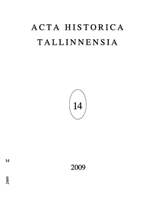EESTI RAHVUSLIKU LIIKUMISE MUDELID UUSIMAS HISTORIOGRAAFIAS
MODELS OF THE ESTONIAN NATIONAL MOVEMENT IN MODERN HISTORIOGRAPHY
Author(s): Toomas KarjahärmSubject(s): History
Published by: Teaduste Akadeemia Kirjastus
Keywords: Estonia; Estonian History; ESTONIAN NATIONAL MOVEMENT ; MODERN HISTORIOGRAPHY
Summary/Abstract: This article discusses the coverage of the Estonian national movement in modern historiography, focusing on the models of the national movement of Estonians in the works of Miroslav Hroch, Ea Jansen, Andreas Kappeler, Mart Laar, Toivo Raun and Ilmar Talve. All these authors have in principle accepted the typology of national movements of European non-dominant ethnic groups as formulated by Miroslav Hroch, according to which any national movement goes through three phases: A – scholarly interest of a small group of intellectuals in the language and culture of a certain ethnos (“pre-awakening”), B – active national agitation by patriots (“awakening”), C – mass movement against the background of clashing special interests of various social groups. Researchers have dated the beginning of the Estonian national movement, which coincides with the start of Phase A, to various periods between 1800 and 1830; the transition from Phase A to Phase B, however, has been unanimously dated to about 1860. Opinions differ on the timing of the transition from Phase B to Phase C, since it is difficult to define and measure a mass movement. According to T. Raun, Hroch’s scheme is not fully satisfactory in this respect, and he identifies the years 1885–1905 as a separate phase. Some researchers insist that the transition of the Estonian national movement from the phase of patriotic agitation to the phase of mass movement took place as early as in the mid-1880s, whereas others are of the opinion that the “awakening” period lasted longer and the mass movement phase started later – not until the turn of the 19th and 20th centuries, in the context of an abrupt politicization of social life and the 1905 Revolution, which for the first time raised the question of Estonians’ cultural and political self-determination (national autonomy). For the supporters of early transition the main criterion is represented by the number of participants in national events (mostly associations and societies noted for their economic and cultural pursuits), which, despite the pressure of Russification, demonstrated a growth tendency towards the end of the 19th century. The advocates of a later transition focus on the qualitative aspect of the movement, the correlation of political and cultural nationalism – placing new radical political ideas and goals on the agenda. According to the logic of Hroch’s model, Estonians reached the phase of mass movement with the 1905 Revolution (his book also provides an earlier timing), subsequently evolving into a modern nation. Hroch’s scheme has Estonians share Type 1 (“integrated type”) with the Norwegians, Finns and Bohemian Czechs. Laar’s model differs from Hroch’s in the sense that Laar places the birth of modern nationalism ahead of the mass movement and bourgeois revolution.
Journal: Acta Historica Tallinnensia
- Issue Year: 2009
- Issue No: 14
- Page Range: 146-171
- Page Count: 26
- Language: Estonian

